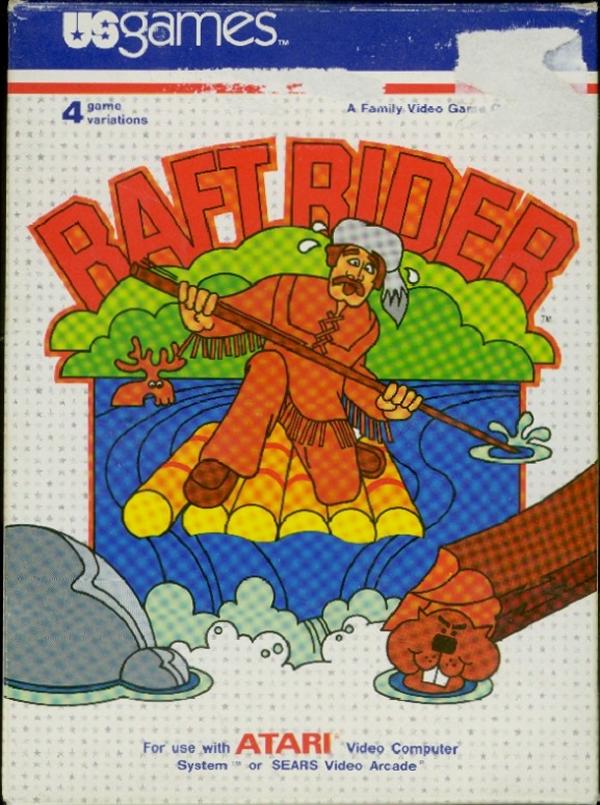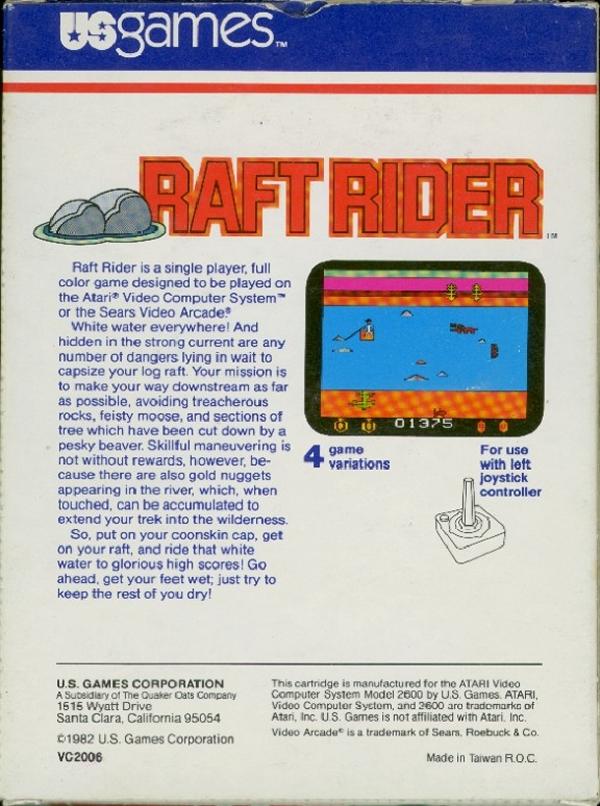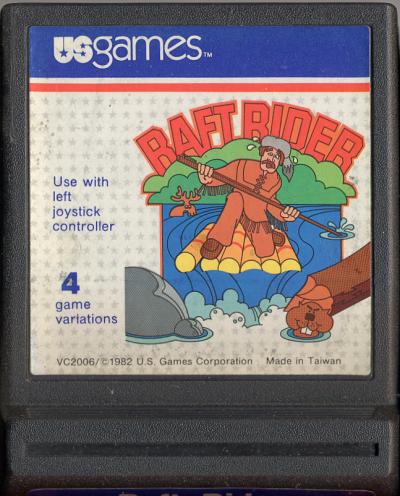Who Needs Manuals?
Raft Rider by U.S. Games
By Adam Trionfo and Chris Federico

Here's a quick introduction to the concept behind this column. Adam came up with an awesome idea: We're playing Atari VCS games that we've never given chances in the past. You know; you play for two seconds, and it's "Nope!" and on to another game. We're seeing if we can figure out all of the mechanics and objectives. Then we're writing about our reactions to these initial attempts -- i.e. before we read the instructions. The second part of our prose about each game will involve our opinions after reading the manual, and playing properly.
It's a good thing that the Atari Age website provides the manual for Raft Rider, or Adam would be having nightmares later: "There must be a reason for the gopher!" This quandary has been dogging him since we hit "Reset" the first time. The reason I'm calling it a gopher, rather than the more river-logical beaver, is that Adam noticed that it's the same graphic from Gopher, also by U.S. Games. The animal occasionally runs from left to right along the screen-bottom shore. I'm contending that he's only there for aesthetic purposes, much like the atypically well-rendered pine trees along the top and bottom shores.
 (U.S. Games)_With_Moose.gif)
I've never liked this game, at least during the two or three very, very brief stabs I've taken over the past several years. I always figured that there was something I didn't know about the control scheme, because the chap standing on the raft often didn't comply with my controller movements. I never bothered to search online for the manual, because I assumed it wouldn't be worth it. The game always felt very tedious, with a lot of control lag; and besides, it's only a river full of rocks and other, less immediately identifiable things, force-scrolling at you from the right: a dime-a-dozen game concept.
So we sat down and said, "Let's see if we can figure out how to control this guy and his raft." He holds a long, slender row or paddle or stick (or dead eel, for all I know), but this still appears to serve only to show you which direction your wild'n'crazy raft rider is facing. We experienced the same intermittent lapse in controller acknowledgment that I mentioned above, but I finally determined that this was due to the game's only random element (other than the particular rock patterns that scroll onto the screen): The "current" often pulls your raft upward or downward, or speeds you up/slows you down. The real problem is that when this occurs, you're powerless to resist the forced movement. This invariably leads to the loss of one of your three rafts.
But Adam was the one who made the truly significant discovery -- the one that changed the game for us. You don't have to keep pushing the joystick to get the raft to move out of the way of an obstacle. Six "rows" exist for your onscreen partner to move into; all you have to do is tap the joystick up or down once, and he keeps moving until he's completely changed to another of the six vertical positions. The patterns of rocks and things conform to these rows, so I made a comment comparing this game to Activision's Grand Prix.

This didn't make the game amazingly enjoyable or anything, but at least we felt more in control, and were getting higher scores (determined by nothing but distance; the longer you survive, the higher your score). Adam noted that his discovery still didn't explain why the player is given left/right control abilities.
I'm still convinced that the up/down/faster/slower changes in current are utterly random, and that, incidentally, the fire button does nothing. Once in a while, a flashing rock appears. You can't grab it; it kills you, just like the other rocks do. Adam joked that it was a mine, but I'm going with that. The occasional river moose (my guess; it's not drawn very well. And I don't care if there's no such thing as a river moose, dammit) appears once in a while, and he moves toward you faster than the other scrolling things; other than that, he's just another obstacle.
The main graphical problem is merely cosmetic: When the raft rider "dies," he begins his next attempt in the same "Aaaargh! I'm dead!" position, and stays that way until you move him. Having said that, the game has impeccable collision detection; as you're switching rows, you can scrape by a rock within a pixel's length. The game commits a major design sin in the Chris Kingdom, however: Sometimes, the groups of rocks (etc.) come at you in such a configuration as to make collision literally unavoidable. The player should always have a chance, no matter how slim in the more challenging games/levels out there. Speaking of which, Raft Rider has no game variations, and we didn't perceive any difference with the difficulty switches flipped to "A."
The game is still not much fun, but at least Adam's realization that you can easily switch between implied rows makes it playable. The regularly delayed control response is still annoying, and for chiefly that reason, I can't see myself returning to this game at all, other than perhaps to fondly recall my and Adam's entertaining attempts at finding something fun about it. Speaking for myself, I didn't. - Chris F.
 (U.S. Games)_With_Beaver.gif)
In Raft Rider, you play Drunk Farmer Brown, who must maneuver down a slow-moving river while avoiding rocks, logs and other water hazards. Farmer Brown must make his way to his garden before the hungry gopher, who travels along the shore, can get there to steal the golden carrots.
Farmer Brown's time at the bar before his river adventure has left him inebriated. He is unable to remember how to properly beach his craft without crashing. For this reason, he cannot leave the river until he reaches his garden at the end of the level.
The gopher has some friends who are helping him achieve his goal. There is the menacing River Moose. Be careful, as these animals are known to travel in packs of Wild Meese, which are much more menacing to the farmer. Also, there are the upside-down pine trees on the lower river bank. These trees are at one with nature, and share a psychic link with the river. When the farmer doesn't expect it, the river will suddenly toss him along in the most unexpected of ways. It may SEEM as though underwater currents are doing this, but remember that it's those no-good trees and the gopher!
And they're not his only friends. There is the dreaded fresh-water shark. All it takes is running into his fin to knock the farmer from the raft. Due to ROM limitations, the bloody, red water just would not fit into the game. Those routines were later saved and used in Mortal Kombat. The rare, underwater, two-humped camel also poses a terrible obstacle. One thump or bump into one hump and the farmer goes dump!
Luckily, this river was originally created on an 8-bit game console, so there are actual paths along the river, not continuous movement. Pressing up or down moves the farmer from one path to another.
The player can also move the controller left or right, which makes Farmer Brown whack his oar in the chosen direction. Unfortunately, it was getting close to the game's deadline, and the programmers couldn't decide on anything useful to do with these great-looking left/right graphics. So this only remains in the game as a gimmick, something of a wow-factor for the younger players (those same kids playing Sneak'n'Peek). - Adam T.
Okay -- we've read the manual. The animal at the bottom is a beaver, and it does have the barest hint of a superficial reason for existing: After you see him run by, you can expect one of those unidentifiable obstacles I mentioned to appear from the right, among the rocks. It's a tree that has fallen into the river, after the beaver has allegedly gnawed it down (shortly after exiting the screen, I guess). The singular tree is just as easily avoided as the rocks, other than in one of those impossible situations I described; a singular addition to the many impediments doesn't add anything to the game, either way.
More significant is that you can pick up those flashing rocks, which are gold nuggets. When one appears in the second or fourth row from the top (my observation; it could conceivably happen elsewhere), you can just run into it, as long as your pole is facing straight ahead of you. Everywhere else, obtaining the gold requires changing rows just in time to move past it as it scrolls toward you, while you fight the delay in left-right control to get your pole facing forward in time. You see, whenever you move up or down, you face backward for a second. I suppose this is supposed to imply a paddling motion. If you manage to touch the nugget with any part of your pole, a money bag appears in the lower left corner of the screen. When you've collected three, you get an extra life.
Knowing about this should add something to the game, but it actually decreases the fun, at least for me; the awkward controls cause gold-grabbing to be so difficult that I usually crash while trying. It defeats the purpose, especially considering that you can't rack up your lives; you can only have four at once. I survived longer before I knew about the gold, when I was only concerned with dodging things.
An interesting question that Adam posed was whether or not I believe that I would have played Raft Rider a great deal if, back in 1982, it was one of the very few games I had. I can now answer: Yes! Absolutely! No question! Provided that the others all needed the keyboard controller, which I didn't own.
But I guess I'm being rather tough on the game. It works like it's supposed to, and there are no bugs. There are some minimal difficulty alterations available: The difficulty switches do indeed change the game a bit. Left "A" speeds up the overall current, although this only worked during one test-flip of the switch, so maybe this still only happens after you've been playing for a while. Right "A" is what causes the moose to move forward, making his approach faster than the rocks and other things. The controls that I keep going on about are detrimental to the enjoyment, so it simply doesn't hold my interest. - Chris F.
After reading the instructions, I see now that there are far less underwater camels and dangerous sharks than I thought. Indeed, those detailed graphics are meant to be ROCKS in the river. Now, tell me, why would a game company invest weeks in making such detailed graphics, only to call them rocks in a river? It truly is no wonder that U.S. Games went back to making oatmeal!

Well, sure, my review before reading the directions was a bit overzealous. Perhaps I did read too much into the game. Can you blame me? And after finally reading about what I'm doing as the player, I'm left with a sour taste in my mouth. I AM really just floating down a river, avoiding rocks and limbs. The beaver that runs along the bottom of the screen (the animal I referred to as a gopher) has no purpose in the game whatsoever, EXCEPT to warn the player that a limb is coming up ahead, so BEWARE! Watch out. You could be knocked off your raft, if you're not careful. Well, no SHIT! It isn't like EVERY obstacle in the river can't knock me off my raft.
In my first review, I failed to mention the blinking rocks. These happen to be gold nuggets. Collecting three of these will give the player a bonus raft. You can't touch these with your raft, or else you will be knocked off. You have to touch the nuggets with your oar to retrieve them. Which makes sense to me, since the oar is a nice, precise, BLUNT instrument with an extremely accurate mechanism made exactly for picking nuggets of gold out of a river. (I'm shaking my head back and forth now, and saying aloud, "I'm such a stupid asshole." Chris, who is nearby, has this response: "That usually means you're writing something really funny.")
There isn't enough to do in Raft Rider. Your rider (not farmer!) doesn't move quickly enough, and the game can unfairly deny you clear pathways that allow you to pass to safely between the rocks. The only pick-up items for the player are the gold nuggets, but choosing to grab one of these shiny treasures is just about as likely to help you gain a free raft as it is to flip you off your current one. The player is probably better off just floating along down the river, avoiding the rocks as best as possible until boredom sets in.
I try to put games into historical perspective. In 1982, what did Raft Rider offer a game player? The game actually does have fair to good graphics. The colors are rich and vibrant. The raft actually DOES look like a raft. Chris was actually able to pick out that the moose was a moose (no small feat for the Atari 2600).
The game's controls are a little sluggish, but I can't decide if that is because they are poorly programmed, or if it's meant to make the game more realistic. Certainly it is true that a raft wouldn't be able skirt its way quickly around rocks... but at the same time, this is a GAME. We're not looking for realism here. We're looking to have a good time. It isn't often that I say "Damn, that Atari 2600 game is just TOO realistic," but in this case, I'm going to go with this assessment. The game's controls were programmed well, but the sluggishness of moving across the river is MEANT to be in the game.
It's not necessary to "steer" clear of this game. If you happen across it, you may find some enjoyment in it, if you can play by its rules. I do feel compelled to say that in 1982, US Games should have given me a call. I would have told them straight away, "Those rocks SHOULD be sharks... with lasers on their heads. That's all I'm asking for!" - Adam T.